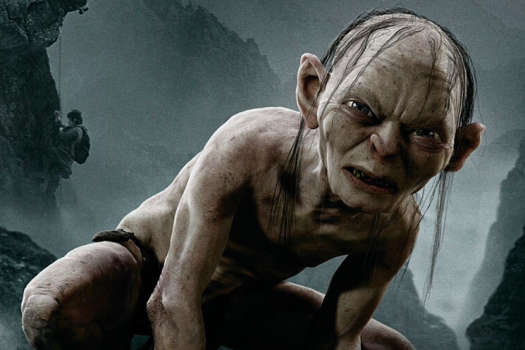The vaquejada is a sport popular in the Northeast region of Brazil, wherein two cowboys on horseback pursue a bull in a ring and attempt to pin it between their horses and knock it over near a marker or goalpost. The title of Gabriel Mascaro's second feature narrative film, Neon Bull, refers to the midnight special, which repeats the same endless cycle of release and capture, only with a bull covered in blacklight paint.
This pattern of repetition, visualized throughout the film by a loop of bull captures, is both a metaphor for — and the literal quotidian reality of — Iremar (Juliano Cazarré), a cowboy working behind the scenes of the vaquejada circuit, and his co-worker Galega (Maeve Jinkings), a hard-working single mother balancing the long hours of the job with raising her energetic daughter, Cacá (Alyne Santana). Though Iremar dreams of being a designer, drawing clothing on the naked women in Zé's (Carlos Pessoa) well-used skin magazines (many pages are stuck together) and collecting bull tails to make manes for fetish costumes (Galega occasionally dresses up like a nearly nude horse and does erotic interpretive dance for a crowd), there's a sense that he, like these bulls, will never escape.
Despite this generalized cyclic thematic trajectory, Mascaro doesn't depict this lifestyle as particularly dreadful. There's nothing patronizing or even overtly political — class system and rural/urban dialogues are left outside of the frame — about Neon Bull. If anything, it's mostly comic and observational, shoving itself into every nook and cranny of this world, voyeuristically detailing public and private moments with a decidedly prurient, scatological gaze. None of these characters appear to be unhappy (and even if they were, it wouldn't be overt, as Mascaro is far more interested in capturing candid moments than manufactured histrionics), but they do make comments about having a better life. Galega tells Cacá she should live with her grandmother and go to school, and Iremar spends every spare moment he has creating new designs.
Beyond the innate feeling of authenticity that permeates every single frame — even a scene where Iremar masturbates a horse in an effort to steal its expensive seed appears to be (and may just be) real — there's an intriguing gender dynamic that emerges. Iremar, the designer, typically does aesthetic work like grooming bull tails and opening gates, whereas Galega is often seen fixing trucks or doing hard labour, but even this pseudo-reversal of the gender paradigm isn't pointed or forced. These aptitudes stem from points of interest rather than anything prescribed by social expectation. And though Galega and Iremar are presented as equals, their individual identities aren't modified by their roles in the labour force. Both are still seen as sexualized beings (Galega indulging in cunnilingus with a new employee near the bull pen and Iremar having a very graphic bout of intercourse with a very pregnant security guard), albeit in a somewhat detached, animalistic sense.
This dynamic stems in part from Mascaro's cold and uncompromising eye. Aside from the clothing and the endless mewling, there's very little distinguishing the humans from the livestock they take care of. When we see Galega get eaten out, it's deliberately pushed to the side of the frame, with most of the tableau being comprised of bulls indifferently standing around; there's also no real distinction between watching Iremar take a steaming morning piss in the middle of green space and watching one of the horses do the same. As such, it seems that the preoccupation with shit and genitalia, whether the gang is laughing about Cacá falling into a pile of cow dung or we're watching Galega wax her pubis in the driver's seat of a truck (an image that almost mocks modernist social customs with its contextual absurdity), there's a dehumanizing sensibility to it. Just as the livestock is reduced to little more than shitting, fucking and being used for somewhat boorish entertainment, these people are just workers with sexual urges that crap and piss and have the misfortune of being conscious enough to dream for more.
And though these dreams are partially visualized — Iremar gets to see what his fantasies might look like (sort of) near the end of the film — the cycle of familiarity ultimately loops back around. Of course, since Mascaro tells this story with such an impartial eye, this notion of being caged seems like more of an observation about the human experience — or the experience of living in a society as a mammal — than this lifestyle in particular. And since we're privy to the intimate inner-workings of this world, seeing the best and worst of what it has to offer, we get an exhilarating sense of witnessing something we shouldn't be allowed to see, which is sort of tantalizingly taboo.
(Memento Films)This pattern of repetition, visualized throughout the film by a loop of bull captures, is both a metaphor for — and the literal quotidian reality of — Iremar (Juliano Cazarré), a cowboy working behind the scenes of the vaquejada circuit, and his co-worker Galega (Maeve Jinkings), a hard-working single mother balancing the long hours of the job with raising her energetic daughter, Cacá (Alyne Santana). Though Iremar dreams of being a designer, drawing clothing on the naked women in Zé's (Carlos Pessoa) well-used skin magazines (many pages are stuck together) and collecting bull tails to make manes for fetish costumes (Galega occasionally dresses up like a nearly nude horse and does erotic interpretive dance for a crowd), there's a sense that he, like these bulls, will never escape.
Despite this generalized cyclic thematic trajectory, Mascaro doesn't depict this lifestyle as particularly dreadful. There's nothing patronizing or even overtly political — class system and rural/urban dialogues are left outside of the frame — about Neon Bull. If anything, it's mostly comic and observational, shoving itself into every nook and cranny of this world, voyeuristically detailing public and private moments with a decidedly prurient, scatological gaze. None of these characters appear to be unhappy (and even if they were, it wouldn't be overt, as Mascaro is far more interested in capturing candid moments than manufactured histrionics), but they do make comments about having a better life. Galega tells Cacá she should live with her grandmother and go to school, and Iremar spends every spare moment he has creating new designs.
Beyond the innate feeling of authenticity that permeates every single frame — even a scene where Iremar masturbates a horse in an effort to steal its expensive seed appears to be (and may just be) real — there's an intriguing gender dynamic that emerges. Iremar, the designer, typically does aesthetic work like grooming bull tails and opening gates, whereas Galega is often seen fixing trucks or doing hard labour, but even this pseudo-reversal of the gender paradigm isn't pointed or forced. These aptitudes stem from points of interest rather than anything prescribed by social expectation. And though Galega and Iremar are presented as equals, their individual identities aren't modified by their roles in the labour force. Both are still seen as sexualized beings (Galega indulging in cunnilingus with a new employee near the bull pen and Iremar having a very graphic bout of intercourse with a very pregnant security guard), albeit in a somewhat detached, animalistic sense.
This dynamic stems in part from Mascaro's cold and uncompromising eye. Aside from the clothing and the endless mewling, there's very little distinguishing the humans from the livestock they take care of. When we see Galega get eaten out, it's deliberately pushed to the side of the frame, with most of the tableau being comprised of bulls indifferently standing around; there's also no real distinction between watching Iremar take a steaming morning piss in the middle of green space and watching one of the horses do the same. As such, it seems that the preoccupation with shit and genitalia, whether the gang is laughing about Cacá falling into a pile of cow dung or we're watching Galega wax her pubis in the driver's seat of a truck (an image that almost mocks modernist social customs with its contextual absurdity), there's a dehumanizing sensibility to it. Just as the livestock is reduced to little more than shitting, fucking and being used for somewhat boorish entertainment, these people are just workers with sexual urges that crap and piss and have the misfortune of being conscious enough to dream for more.
And though these dreams are partially visualized — Iremar gets to see what his fantasies might look like (sort of) near the end of the film — the cycle of familiarity ultimately loops back around. Of course, since Mascaro tells this story with such an impartial eye, this notion of being caged seems like more of an observation about the human experience — or the experience of living in a society as a mammal — than this lifestyle in particular. And since we're privy to the intimate inner-workings of this world, seeing the best and worst of what it has to offer, we get an exhilarating sense of witnessing something we shouldn't be allowed to see, which is sort of tantalizingly taboo.




